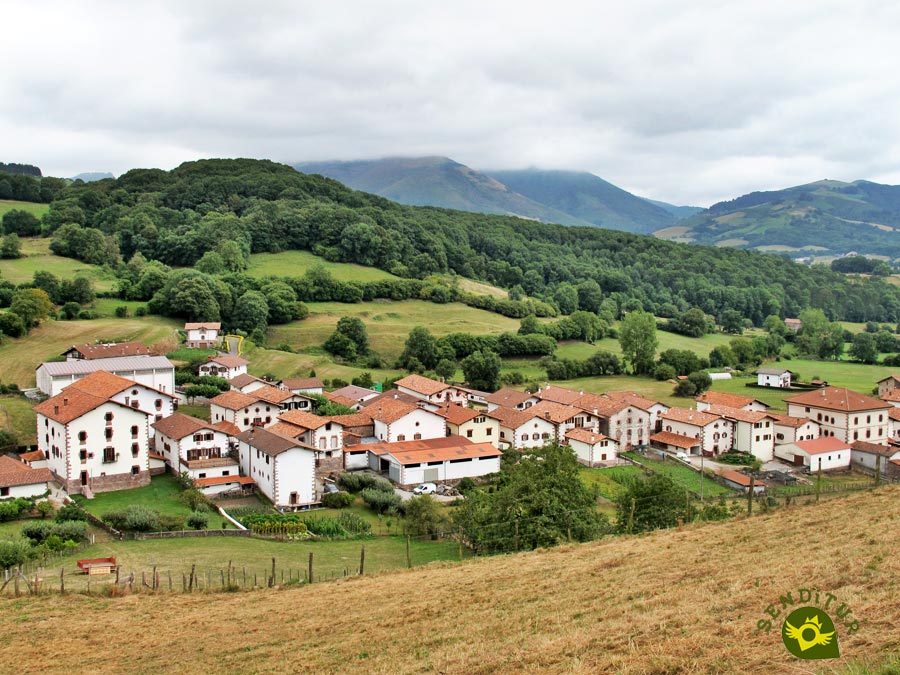Amaiur in Euskera is located in the northeast of Navarre, surrounded by mountains such as the Gorramendi and the Peñas de Bentarte, on the left bank of the river of its name, is integrated into the municipality of the Baztan Valley. We know of ancestral population centres, dating back to around the 13th century BC. The Roman road Bordeaux-Astorga passed through here, which later became the Pilgrim's Way to Santiago Baztanes. In the 11th century Sancho el Mayor granted Semén de Ochoániz, lord of Jauregizar, Amaiur/Maya and Irurita, the lordship of Baztan and in the 12th century Amaiur is mentioned as one of the noble tenancies or districts of the kingdom of Navarre. The castle of Amaiur was one of the last defences to fall against the conquest carried out by King Ferdinand the Catholic, becoming one of the last bastions of Navarre's independence. Navarrese defenders resisted in the castle until 1522, when it was destroyed. Amaiur became a town when in 1665 it was separated from the Baztan Valley, which was annexed three centuries later in 1969.

Maya / Amaiur is a pretty village street, as its houses were built following the path of the Camino and at the foot of its castle located on top of Mount Gaztelu. The first references of the castle date from the 12th century, although it underwent many renovations. The medieval fortress had two lines of walls, which were built between the 13th and 15th centuries, and a central tower whose remains are under the monolith that was erected in the year 1922 in memory of the Navarre who defended it. At the beginning of the climb to the castle there is a monument to the Resistant Unknown, inaugurated in 2007, in which you can read Pro libertate patria, gens libera estate, Standing free people in favor of the freedom of the homeland and in its upper part, the Carbuncle or starry figure symbolizes popular art and it was the precedent of the shield of Navarre and that used Theobald I of Champagne.

In the village you can see palatial architecture in the Arrtetxe palace, from the 16th century, the Arriada house, where they were held together in the 16th century or the Borda palace. Curiously, at the entrance to the town there is a beautiful entrance arch in Mayan, built in 1695 and which was reproduced in the Spanish Town of Barcelona in the Universal Exhibition of 1929, welcomes visitors, but before passing underneath it a cross from the end of the XVII century calls the attention and the church of the Assumption, of medieval origin although it has been reconstructed in the XVI and XVIII centuries, guard of the primitive temple the front of pointed archivolts built in proto-Gothic style at the end of the XIII century. In Amaiur you can also see a mill, which has been restored and is still in operation today, where you can taste the typical talos, which are fine corn cakes filled with cheese, chocolate, chistorra... can sweeten and complete the attractive visit to this charming village.

Maya-Amaiur celebrates the Assumption of Our Lady on August 15.
Oral tradition has it that the town's emblem, which is the bell associated with the chessboard of the valley's coat of arms, is a reminder of the bell used to warn the forces living in the castle of what was happening in the town.
There are fifteen villages in the municipality of Baztan, the largest in Navarre. Between them there are no boundaries, milestones or milestones, all its inhabitants have the right of common use in grasses, pastures, water and wood cuts and all of them, in addition, are hidalgos of origin.

Legend has it that a terrible plague spread throughout the area killing almost all the cattle and when the epidemic reached the boundaries of the locality to reach the arch of Amaiur ceased its virulence and every living being who was on the other side of the arch was saved from contracting the disease.
MORE ROUTES AVAILABLE, DON'T MISS IT...
MORE PLACES AVAILABLE, DON'T MISS IT...
A Maya/Amaiur is reached from Pamplona following the NA-121-A to Oronoz in the first instance, from there we must take the NA-121-B, a road that crosses the whole valley of Baztan towards Dantxarinea and shortly after passing through Ordoqui as we arrive from Pamplona we will find the detour to the right that takes us to Maya/Amaiur.
SENDITUR is not responsible for any variation in the information described as well as the misuse of its guides and recommends that everyone be responsible and prudent in carrying out the activity. Likewise, we invite you to document yourself with books and specialized guides to complement the information described. From the commitment of SENDITUR with Nature and the respect to the balance of the environment, SENDITUR urges you to travel in a responsible way, with low environmental impact and respecting at all times the Natural, Cultural and Social environment wherever you go. For any suggestion, SENDITUR invites you to send an email to .
Continue watching …